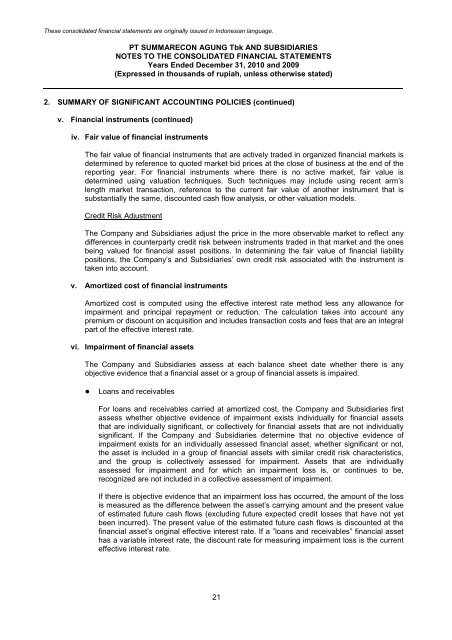PT Summarecon Agung Tbk | Laporan Tahunan 2010 Annual Report
PT Summarecon Agung Tbk | Laporan Tahunan 2010 Annual Report
PT Summarecon Agung Tbk | Laporan Tahunan 2010 Annual Report
You also want an ePaper? Increase the reach of your titles
YUMPU automatically turns print PDFs into web optimized ePapers that Google loves.
These consolidated financial statements are originally issued in Indonesian language.<br />
<strong>PT</strong> SUMMARECON AGUNG <strong>Tbk</strong> AND SUBSIDIARIES<br />
NOTES TO THE CONSOLIDATED FINANCIAL STATEMENTS<br />
Years Ended December 31, <strong>2010</strong> and 2009<br />
(Expressed in thousands of rupiah, unless otherwise stated)<br />
2. SUMMARY OF SIGNIFICANT ACCOUNTING POLICIES (continued)<br />
v. Financial instruments (continued)<br />
iv. Fair value of financial instruments<br />
The fair value of financial instruments that are actively traded in organized financial markets is<br />
determined by reference to quoted market bid prices at the close of business at the end of the<br />
reporting year. For financial instruments where there is no active market, fair value is<br />
determined using valuation techniques. Such techniques may include using recent arm’s<br />
length market transaction, reference to the current fair value of another instrument that is<br />
substantially the same, discounted cash flow analysis, or other valuation models.<br />
Credit Risk Adjustment<br />
The Company and Subsidiaries adjust the price in the more observable market to reflect any<br />
differences in counterparty credit risk between instruments traded in that market and the ones<br />
being valued for financial asset positions. In determining the fair value of financial liability<br />
positions, the Company’s and Subsidiaries’ own credit risk associated with the instrument is<br />
taken into account.<br />
v. Amortized cost of financial instruments<br />
Amortized cost is computed using the effective interest rate method less any allowance for<br />
impairment and principal repayment or reduction. The calculation takes into account any<br />
premium or discount on acquisition and includes transaction costs and fees that are an integral<br />
part of the effective interest rate.<br />
vi. Impairment of financial assets<br />
The Company and Subsidiaries assess at each balance sheet date whether there is any<br />
objective evidence that a financial asset or a group of financial assets is impaired.<br />
● Loans and receivables<br />
For loans and receivables carried at amortized cost, the Company and Subsidiaries first<br />
assess whether objective evidence of impairment exists individually for financial assets<br />
that are individually significant, or collectively for financial assets that are not individually<br />
significant. If the Company and Subsidiaries determine that no objective evidence of<br />
impairment exists for an individually assessed financial asset, whether significant or not,<br />
the asset is included in a group of financial assets with similar credit risk characteristics,<br />
and the group is collectively assessed for impairment. Assets that are individually<br />
assessed for impairment and for which an impairment loss is, or continues to be,<br />
recognized are not included in a collective assessment of impairment.<br />
If there is objective evidence that an impairment loss has occurred, the amount of the loss<br />
is measured as the difference between the asset’s carrying amount and the present value<br />
of estimated future cash flows (excluding future expected credit losses that have not yet<br />
been incurred). The present value of the estimated future cash flows is discounted at the<br />
financial asset’s original effective interest rate. If a ”loans and receivables” financial asset<br />
has a variable interest rate, the discount rate for measuring impairment loss is the current<br />
effective interest rate.<br />
21


